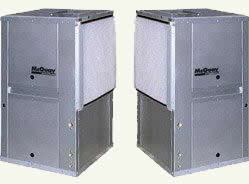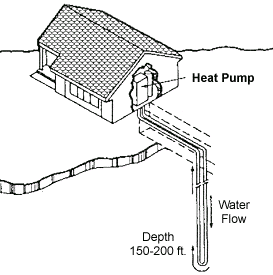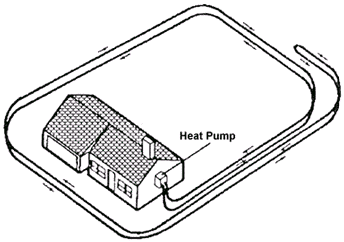
Figure 1 - Geothermal heat pump
Geothermal heating and cooling is not science fiction, it is a proven method of supplying heating and cooling and its acceptance, and installation is growing daily. Savings on yearly energy bills can be as much as 60 percent. In the US, the federal government and many states are providing tax incentives and credits if you install a geothermal HVAC system. Other countries including Canada also have incentive programs. Check out your local electrical utility or government website.
How does a geothermal HVAC system work?
It uses technologies that have been around for many years - pumps and heat exchangers. A well is drilled on your property. The water from the well is then pumped through a heat exchanger in your home where a portion of the latent heat in that water is removed and used to heat your home, as shown in Figure 2.

Figure 2 - Geothermal home installation
In the summer the water temperature is cooler than the outside air. The system then provides air conditioning to your home.
In climates where temperatures fall below 0 degrees, supplemental heating using gas, electricity, or fuel oil may be incorporated into the system.
Electricity is used to power the pump and the circulation fans. There is no cost to the homeowner for the actual heat. No gas or fuel oil is consumed.
Closed loop systems circulate a heat transfer fluid (usually a water/antifreeze solution) through a system of buried or submerged plastic piping, arranged either horizontally (as shown in Figure 4, or vertically, as shown in Figure 3).

Figure 3 - Geothermal Vertical Loop System

Figure 4 - Geothermal Horizontal Loop System
Ground-based horizontal loop systems draw their heat from loops of piping buried 1.8 to 2.4 meters (six to eight feet) deep in trenches. The piping for water loop systems is installed below the winter ice level in pond or lake, or below low tide level in the ocean.
Vertical loop systems use holes bored 45 to 60 meters (150-200 feet) deep with U-shaped loops of piping. They work the same as horizontal loop systems, but can be installed in locations where space is limited due to size, landscaping or other factors.
A geothermal HVAC system is not only cost beneficial, it is very environmentally friendly and it conserves our precious fossil fuels. Geothermal installations are usually not a home handyman home improvement, however for those individuals who are willing to take on more complex projects that require some engineering, some investigation and have patience to make necessary changes if at first it doesn't succeed parts and systems are available for purchase.
Additional Information
